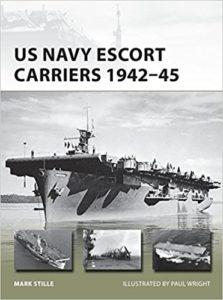 By Mark Stille, New Vanguard Series, Osprey Publishing, New York, NY (2017)
By Mark Stille, New Vanguard Series, Osprey Publishing, New York, NY (2017)
Reviewed by Michael F. Solecki
There were three major types of aircraft carriers in World War II (WWII). The first, very expensive “fleet” carriers, were large, fast, heavily armored, and armed for self-defense, carried over 80 planes designed with major strike and long-range capabilities. The Essex-class was the largest and most capable of WWII. The U.S. had seventeen of these by the end of WWII, with many used continually through the Vietnam War. There was quite an uproar when in 1942 President Franklin D. Roosevelt (also a former Secretary of the Navy) ordered nine Cleveland-class light-cruiser hulls to be converted into aircraft carriers by 1944. *Mentioned in passing by the author, with no detail this third type carrier, the “light-carrier;” became the Independence class (CVL), there were nine built all being launched by mid-November 1943.
*As the reviewer I added this short passage to this review to complete the thought for the reader of this review. The omission of any detail and mention of the light-carrier (CVL), I assume, is the author did not feel it within the scope of this particular edition of the Osprey “New Vanguard” Series publication.
Roosevelt however, favored the third, much cheaper “escort-carrier” (CVE) originally designed and built to provide limited air warfare capability at sea and as aircraft supply ships for the fleet carriers. He foresaw the use of merchant ship hulls with a design speed greater than 15 knots and between 6,000 and 8,000-ton displacement be easily converted into the much-needed air-support at sea. As the war evolved so did the design, from the aircraft transport (APV), aircraft tender (AVG) and auxiliary aircraft carrier (ACV) to the final designation of escort-carrier (CVE). The use and capabilities of these amazing ships also evolved. Much to the chagrin of many of the admirals at the time Roosevelt, thought these smaller carriers could be used instead of the more expensive large fleet-carriers for aircraft supply and convoy escort duties providing scouting and anti-submarine duties. Through most of the war, many admirals were time locked into the Mahanian mindset (known by many naval historians including myself as the “big gun club”) thought the construction of more carriers of any type a waste of valuable resources. They were still not convinced that naval aviation was a viable means to victory, that fast ships with big guns were the way to achieve victory in the proverbial “decisive” battle, as did many in the Japanese Admiralty.
When finally fully engaged in the war, the missions or roles of the smaller carriers ranged from escort, supply and relief service to tactical missions such as close ground support, island invasion preparations, combat-air-patrols (CAP) and more. In general, the escort-carriers maintained in the neighborhood of twenty-five planes, 50% fighters plus a mix of torpedo planes and dive bombers depending on the mission. They were organized into divisions of three carriers each usually assigned to a major fleet force or a task group. Occasionally they operated independently with a small surface fleet of their own. The point is they were mission flexible because there were plenty of them as they were cheap to build and operate; keeping the fleet carriers available for the larger more strategic missions.
Due in large part to the escort carriers by the end of the war little convincing of the admirals was needed to prove the value of naval aviation. There were five classes of the escort-carrier, the Casablanca being the largest and most innovative in hull, power-plant and logistic design. The “escort-carrier” played a large part in the Allied naval success in WWII in both the Atlantic and Pacific theaters. They and their crews took everything the Axis navies could throw at them from the air above to submarines below including “kamikaze” attacks.
As usual, I read this book three times the first for readability, second for technical accuracy and third for grammar. The lack of the mention of light-carriers (CVL) aside, this edition is concisely written at the secondary education level, well organized, with many illustrations and cutaways and photographs when available. Well researched, packed with information and definitely worth the price; highly recommended for a “quick” look at the “Escort Carriers” of World War II, also provides a decent bibliography for further research.
Michael F. Solecki: is an independent naval historian, holds a Master of Arts in Military History from Norwich University as well as undergraduate degrees and graduate certificates in engineering and the physical-sciences; is a U.S. Navy and NOAA veteran specializing in environmental intelligence for Anti-Submarine and Anti-Aircraft Warfare and developing consequence management plans. He is currently an Enforcement Officer and Emergency Response On-Scene Coordinator for the U.S. Government and performs technical peer reviews for several publishers of U.S. and Japanese naval history.

